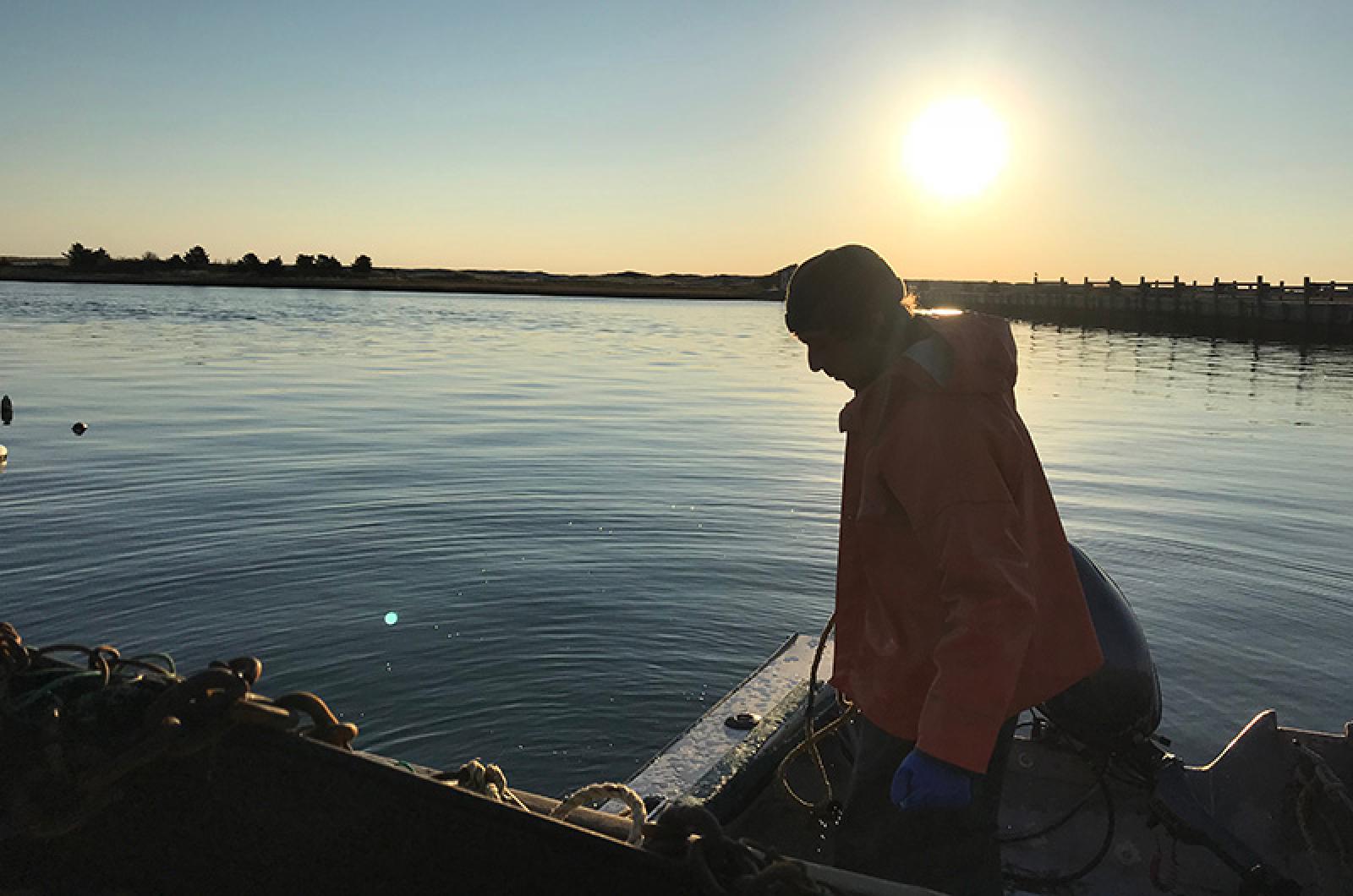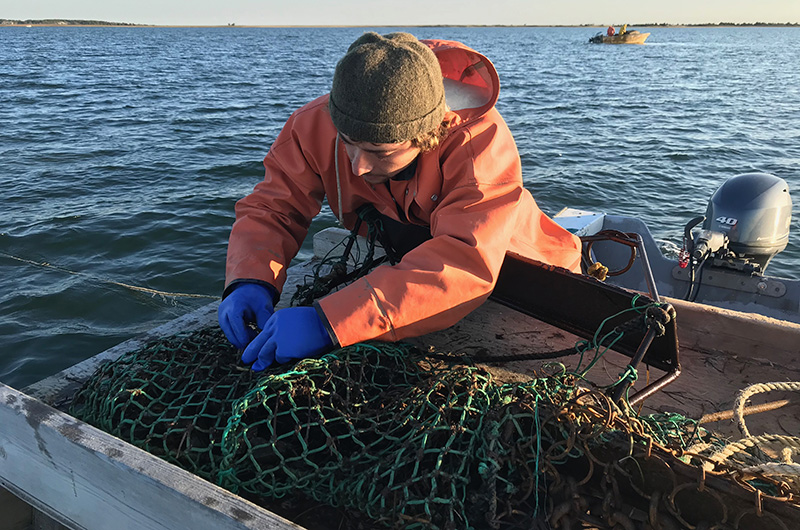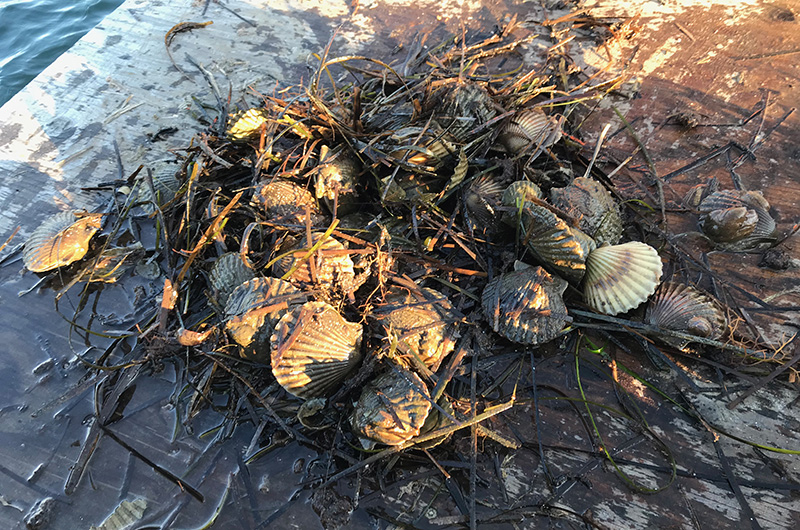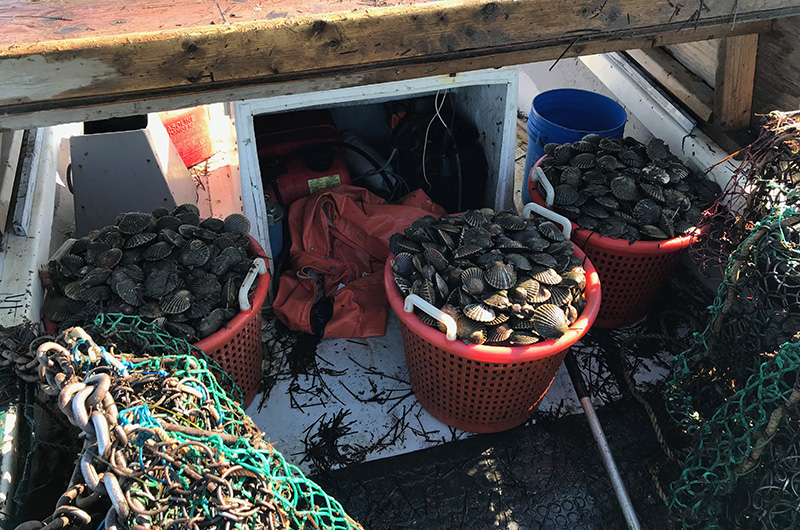It’s November, and that means bay scallop season has arrived on the Vineyard. But by most accounts, it will be an average to poor year for scalloping, both up Island and down.
“It’s been a really slow year,” said Edgartown fisherman Arno Ewing as he steered his skiff into Cape Pogue Pond Monday morning. “But that’s after three really good years in a row. So it’s what you can expect.”

Commercial and recreational scalloping is now open in every Island town. Scalloping is an important winter industry for independent Vineyard fishermen who rely on the Island’s historically rich saltwater ponds to drag or dipnet for the high-demand shellfish crop. But in recent years, pollution and coastal development has threatened the notoriously fickle bivalves, and early reports from Island towns have painted a grim outlook for the 2018-2019 season.
“It’s not a banner year, by any means,” Edgartown shellfish constable Paul Bagnall said this week. “We’re cooking along with 25 to 30 limits a day, which isn’t too bad. But last year we were doing around 45 to 50. It was regionally a good scallop year, and this year, well, it’s looking to be regionally a not so good scallop year.”
Last year, Edgartown issued 100 commercial scalloping licenses. This year, the town has not yet reached 80. Still, Mr. Bagnall said he feels fortunate that there are any scallops at all in Cape Pogue Pond, Edgartown harbor, Katama Bay and Sengekontacket Pond.
“We’re lucky we have them, we just don’t have a lot of them,” Mr. Bagnall said. “There’s never any easy scalloping. There’s just good scalloping, and bad scalloping, and I would put this in the mediocre quality.”
Other towns aren’t so lucky. In Tisbury, where scallops have historically been abundant in the shallow waters of the Lagoon Pond, shellfish constable Danielle Ewart and her committee made a tough call — deciding to close the pond to scalloping just one week after the season opened Oct. 27. The reason was to protect a large crop of juvenile scallops.
Ms. Ewart said in the first week no commercial scallopers had gotten their limit, and even recreational dip-netters were finding few adult scallops.
“There is a cycle, there are ups and downs to it,” she said. “You’ll have a really good year, then you’ll have a bad year . . . but this is like the worst year I’ve seen so far.”
Bay scallops are the only seasonally harvested shellfish on the Vineyard. The mollusks have a three-year life span but become legally harvestable at age two, after they’ve spawned. While only about 10 per cent make it to age three, fishermen can get a good sense for a season’s outlook by the number of one-year-old juveniles, or seed scallops, they find while culling.
“We didn’t see a lot of seed from last year,” Ms. Ewart said. “Last year was a good year for adults, but bad for seed.”
Chilmark opened its commercial scallop season in Nashaquitsa Pond earlier this week while other areas, including Stonewall and Menemsha ponds, will open the beginning of December. But low yields in Nashaquitsa may force shellfish constable Isaiah Scheffer to open the other areas sooner.
“We might have to have an emergency meeting to open up other areas,” Mr. Scheffer said, “because the guys have been out there, and it’s not good.”
Scallops rely on eelgrass as a habitat to prevent silty, mud-filled pond bottoms from clogging their gills. Ever since Nashaquitsa Pond saw a widespread eel grass dieoff three years ago, Mr. Scheffer said it’s been difficult to cultivate a healthy scallop set.
“The eelgrass used to grow tall enough that they’d rest off the bottom,” he said. “One guy went on Tuesday, and he did get his limit but it took him four hours. I feel so bad for those guys, you know, the people relying on it. It’s pretty unfortunate.”
Arno Ewing is one of the fishermen who relies on commercial scalloping to put food on the table. He has a two-year-old son, Jaime, and said that while scallops can be profitable, variability from season to season makes it a tough way to earn a living.
“It’s big highs and big lows, I guess,” he said. “You’ve got to get every day in that you can.”
Mr. Ewing was out on the water by 7:15 Monday morning. He keeps his 19-foot boat, the Pointer, at the Dike Bridge on Chappaquiddick. He cruised through the channel using ranges, like a dip in the trees or the top of a cell tower, to determine his dragging spot. He’s been scalloping in Cape Pogue since he graduated from high school nine years ago. He’s now 28.
“Scallops, I love them. I just love it so much,” he said, watching as the sun rose over Chappaquiddick’s eastern shore. “You get to come down here every morning to come to work. There’s nothing like it.”
After getting to his preferred spot, Mr. Ewing peered into the water to check which direction the eelgrass was flowing. Scallopers want to tow in the opposite direction of the tide to make sure they collect the mollusks rather than drag over them. It took him five tows to get his limit, a surprisingly quick morning considering the tough season.
“It’s kind of miraculous,” he said. “What a pleasant surprise we got enough. In a good year you can get your full limit in one tow, but that’s not the case anymore. I’m so psyched we did it in five.”
On a calm, relatively mild November day, there were 18 other boats out on the pond, more than Mr. Ewing said he has seen all season. Although this year is not the best, he thinks there’s a future for scalloping on the Vineyard.
“I think that this pond has a lot of hope because the development has been so low,” he said. “The development has been what’s wrecked a lot of the ponds on the mainland. Where you see a lot of houses, you are probably going to see fewer scallops.”
While Mr. Bagnall expressed similar concerns about coastal development, he also has reason for hope.
“Westport had a phenomenal year last year,” the longtime constable said. “That in itself is hopeful in my mind. If you’re seeing the western shore, Buzzards Bay area have scallops, that’s a fairly urban area by our standards. But we’re all still a shadow of our former self.”
For the time being, Mr. Ewing says he will continue to find whatever moment he can to get out on the water. It’s not just a way to make a living, he said, but a way for him to get closer to both nature and the Island he calls home.
“The wildlife, that’s my favorite part about scalloping,” Mr. Ewing said. “It really does feel like a privilege to be allowed to do this, like this, in such a delicate area.”











Comments (3)
Comments
Comment policy »